
Bus Rapid Transit (BRT) is a new form of public transportation using large-capacity buses to provide a service on a dedicated bus lane that is of a higher speed than an ordinary bus line.
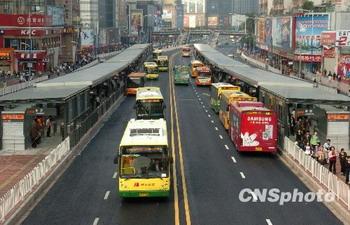
Scope of BRT Service
Guangzhou's BRT system runs from Xiayuan to the Tianhe Sports Center, extending 22.9 kilometers with 26 stations, which, from west and east, are the Tiyu Zhongxin (Tianhe Sports Center), Shipaiqiao, Gangding, Shida Jida (South China Normal University and Jinan University), Huajing Xincheng (Huajing New City), Shangshe, Xueyuan, Tangxiacun, Tangdong, Tianlang Mingju, Chebei, Dongpuzhen, Huangcun, Zhucun, Lianxi, Maogang, Zhujiangcun, Xiasha, Wuchong, Huangpu Keyunzhan (Huangpu Coach Terminal), Shuanggang, Shachong, Nanhaishenmiao (South Sea God Temple), Miaotou, Nanwan, and Xiayuan.
BRT Trial Network
There're 31 BRT routes, consisting of thirty routes whose route numbers begin with the letter B, and one shuttle route, the B1 route, on which the bus runs back and forth along the 22.9-kilometer trial line between Tiyu Zhongxin and Xiayuan. The 30 flexible routes operate on the dedicated bus lanes on the BRT trial line. BRT buses on these routes are deemed as ordinary buses after they exit the trial line on Zhongshan Avenue and run alongside regular buses.
Fare
The fare for a single journey is fixed at RMB 2, and passengers transferring between different BRT routes in the same direction at the same station do not have to pay extra. Passengers are expected to make the exact payment for their fare as no changes are available. Passengers transferring between different directions or stations or outside the BRT lanes are expected to pay extra.
Service Guide
First, a passenger should determine the direction of the bus which runs to his or her intended destination (for example, an east-bound passenger needs to board a bus at an S station, while a west-bound passenger should board a bus at an N station). The passenger may find the sub-stations (for example N1 and N2) at which the bus on the route that he or she is going to take on the line information displayed on the sign at the intersection between the street-crossing facility and the sidewalk. The sign will direct the passenger to an overpass (or an underpass) corridor, where a sign will direct him or her down to the BRT station ticket channel. After paying the fare with cash or Yangchengtong or showing the pass, the passenger may walk through the turnstile, proceed to the BRT station, and wait at the waiting area of the sub-station as directed by the signs.
1. Getting to the BRT
At present, a passenger may get to the BRT via the overpass, the street crossing, the underpass or the metro tunnel.
The passenger may find out the name of the BRT station, the code numbers of the routes, and the guide map on the station sign at the intersection of the street-crossing facility. The passenger should then walk into the street-crossing facility as directed by the arrows. At the intersection between the overpass or underpass corridor corner and the BRT station, the passenger may find out the sub-station from which he or she will board the bus according to the name of the stations, numbers of the sub-stations, and the code numbers of the routes (including a comparison between the new and old code numbers).
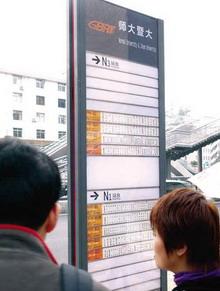
The Station Sign at the Street Crossing Facility Intersection
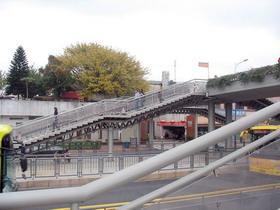
BRT Overpass
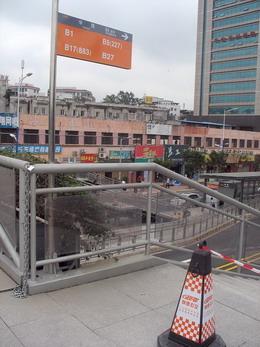
Sign on an Overpass
2. Getting to the BRT Station
They are two accesses to the BRT station the "cash" access and the "card" access. The passenger is expected to make the exact payment with bills or coins or swipe his or her Yangchengtong (or a concession card with Yangchengtong functions) before proceeding to the station.
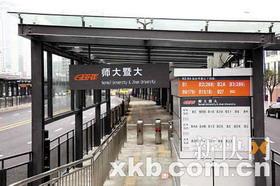
BRT Station
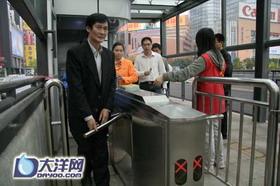
Swiping a Card to Enter the Station
3. Waiting for the Bus
After walking into the BRT station through the turnstile, the passenger should find the relevant waiting area for the route he or she is going to take according to the directions at the station. While waiting for the bus at the station, passengers should not stand beyond the yellow line at the station.
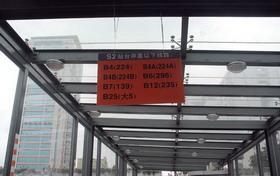
BRT Station Sign

Yellow Alert Line at BRT Station
As BRT buses follow the "first in, first out" rule, buses on different routes at the same sub-station will stop in sequence at the front.
Passengers should find out the position of the bus at the station from the LED electronic board, and forecast the position of the bus according to the "front parking" rule, and then wait at the relevant sub-station near the parking space of the bus.
A bus on the B1 shuttle route (the one BRT route running the entire length of the BRT lane from Xiayuan of Huangpu to the Tianhe Sports Center) can be boarded at the last sub-station at the station.

Electronic Announcement System at BRT Station

Waiting in Line for a Bus
4. Using a BRT Bus
When a BRT bus stops at the station, the safety gate will automatically opens. Passengers should get on via the front door and get off via the back door.
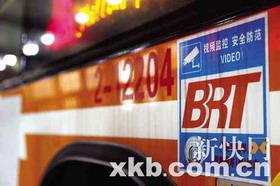
BRT buses are painted orange
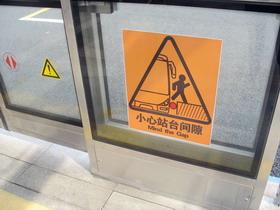
Auto-induction Safety Door with an instruction
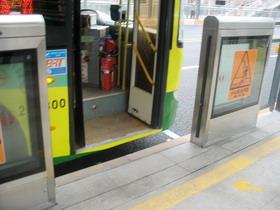
The barrier gate opens when a bus stops at the station.
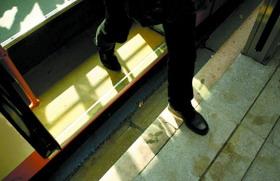
There is an about 45-centimeter gap between a stopped bus and the curb of the station. Passengers should mind this gap when getting on or off the bus and be careful not to fall down.
5. Transferring
There are seven stations equipped with "transferring lanes" where passengers may transfer to another route. They are the Shida Jida (South China Normal University and Jinan University), Shangshe, Xueyuan, Tangxiacun, Tianlang Mingju, Huangcun, Zhucun.
When transferring at a BRT lane or walking from one substation to another in the same direction, do not walk out through the turnstile. A passenger may proceed to the sub-station at which buses on the desired route will stop via the "transferring lane" or the station platform; otherwise, the passenger will need to pay the fare again.
Passengers may transfer to a route in the same direction at the same station without having to pay again. However, passengers need to pay again when transferring in different directors, between different stations or beyond the BRT lane.
6. Exiting
After getting off a BRT bus, passengers are expected to walk into the station via the safety door. Do not walk on the bus lane or walk across the bus lane to the lane or station on the other side, as it's dangerous to do so.
When getting off the bus, please mind the gap between the vehicle and the curb of the station.
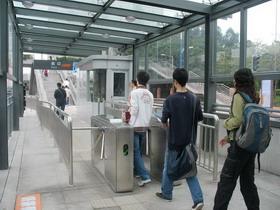
Passengers exit the station in line
Bicycle Parks
There is a bicycle lane along the entire length of the BRT system, and five bicycle parks are provided; most of them are located on the western section of the BRT system at the Huajing Xincheng Station, Shangshe Station, and Xueyuan Station. Cyclists may proceed to a BRT station and transfer to a BRT bus.
Metro Connections to the BRT System
Seventeen metro stations are connected to the BRT system. They are Gangding, Xichang, Quzhuang, the Zoon, Zhujiang New Town, Wuyangtun, Keyun Road, Jubei South, Dongpu, Sanxi, Yuzhu, Dashadi, Dashadong, Wenchong, Tiyue West, and Sports Center. Metro passengers intended to transfer to the BRT system should note the BRT instructions at these metro stations.
Cautions:
1. As there is a gap between the safety door of the BRT station and the stopped bus, passengers should note the warning posted on the bus door and the safety door of the station when getting on or off the bus. Be sure to watch out for the gap between the safety door and the bus.
2. The "get on via the front door and get off via the back door" rule, which is used by ordinary buses, applies both inside and outside the BRT lane.
3. Passengers are expected to pay their fare first and then wait for the bus. Passengers should pay their fare with cash or Yangchengtong and then proceed to the station to wait for the bus. Once on the bus, the passengers do not have to pay again, while on ordinary buses, passengers are expected to pay their fare with cash or Yangchengtong while getting on.
No extra payment is required when transferring in the direction at the same within the BRT lane.
4. Passengers should pay attention to the time of the last bus at night. If the time of the last bus has passed, don't pay and enter the station through the turnstile, as the fare cannot be refunded. In front of the turnstile, there is a sign showing the time of the last bus. To catch the last bus, note its time first.
There is also a black infrared alarm before the turnstile. If the last bus has departed and a passenger still tries to get into the station, the alarm will alert the dispatching center, and the attendant at the dispatching center will notify the passenger through the station's speaker system.
5. Non-public vehicles entering the BRT lane will be subject to a fine of RMB 200 and a deduction of two points.
Q&A
1. How do I know the changes in the BRT routes and their original corresponding routes?
The changes are displayed on the sign in the corridor of the street-crossing facility, the bulletin board in front of the staff room, and on the route sign in the lighting box at the sub-station.
2. How do I tell the BRT stops on the route sign?
In the lighting boxes at the BRT station and street-crossing facilities, the stations in a blue font on the route sign are other BRT stations and the station in a red font is the station where you're now at.
3. What do N and S on the sign mean?
N stands for stations to the north (west-bound); N1, N2 and N3 represent sub-stations 1, 2 and 3, respectively, to the north (in the sequence of the arriving buses). Similarly, S stands for stations to the south (east-bound); S1, S2 and S3 represent sub-stations 1, 2 and 3, respectively, to the south.
4. How can I find out the bus arrivals?
BRT buses automatically announce their stops. In addition, there is a station name sign in the middle of the bus which is similar to the one on the metro train. Each station has a small light. The stations which have been passed are shown in red, while the stations which have yet to reach are shown in green.